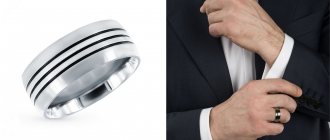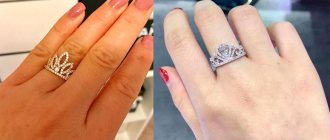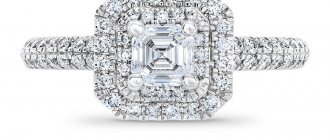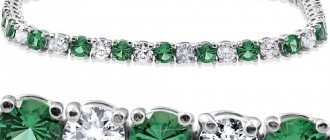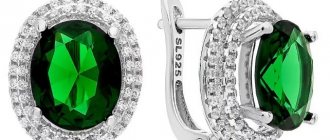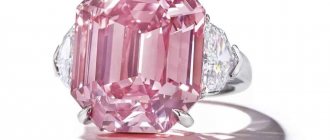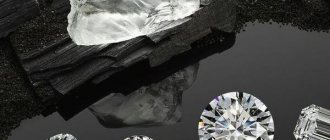Diamond cutting is not only a complex process of polishing jewelry diamonds and giving them a certain shape.
This is one of the main characteristics, including stone parameters, proportions, location and symmetry of edges, and polishing quality.
After all, by nature, a diamond is endowed with only inner beauty, and skillful processing reveals it.
Thus, thanks to the skill and creativity of the jeweler, a diamond is born from an inconspicuous-looking mineral - a stone with an amazing shape and unique shine.
What makes this stone so unusual and valuable?
It's not just its weight, color and purity. In order for a cloudy diamond to sparkle with its ideal facets, real skill and talent of cutter jewelers is required. The shape of the future diamond is chosen with special care to be able to demonstrate the full potential of the stone.
Today, about 15 cutting options are known, and each of them has its own characteristics. However, it is worth remembering that human imagination is limitless and in the future, more than one, no less spectacular and interesting form will probably be invented, which will give enthusiastic diamond admirers thousands of sparkling facets.
Varieties of Black Gem Minerals
Mother Nature brought a surprise even among these wonderful and amazingly beautiful black diamonds. How can there be two different and significantly different types of them? Everything is very simple.
- The first type of black diamond is beautifully called carbonado. This name comes from the Spanish word “carbon”, which translated into Russian means “coal”. He actually resembles him. An inexperienced person may indeed confuse him.
Carbonado has been known since the beginning of the 18th century and is not found in deposits with other diamonds, which emphasizes its uniqueness. It itself has a porous base and a multicrystalline lattice, which is formed from tiny diamonds and “welded” using silicon and a compound known as magnetite (a mixture of graphite and iron compounds).
This type of diamond is not only distinguished by its inherent incredible hardness, but also has a unique strength. The porous base and the properties listed above allow it to be used only for technical and production purposes.
This mineral element is very difficult to cut and polish (and about 60 percent of the total weight of the stone is lost), as a result of which it has practically no value for jewelry and also has no monetary value.
- Another type of stone is called “pique”. It is also called natural or natural black diamond. Unlike the previous type, it has found its application in jewelry because it is a true brother of the original diamonds with the same structure.
It comes not only in black, but also in grey, green and brown. Sometimes color combinations of all these shades are possible. This unusual color mixture arose as a result of dusty inclusions of graphite or other impurities and formations entering the structure of the diamond during its formation.
Round classic cut
The familiar round shape of a diamond is recognized as the most beautiful, capable of presenting the stone most advantageously and effectively. A regular round cut diamond has 57 facets.
Advertising - Continued below
For very small stones, a simplified cut of 17 facets is used, and for the largest stones there are options with 74, 86 (royal cut) or 102 facets (majestic).
Diamond, step and mixed cuts
Brilliant cut is a method of diamond processing in which the arrangement and number of facets give the stone maximum brilliance. This is a perfectly calibrated diamond shape, revealing its ability to reflect and refract light. For example, the classic round cut of a gemstone is a brilliant cut. Such a stone must have 57 facets.
A step cut is characterized by a strictly parallel arrangement of edges, which means the shape of the stone will be square or rectangular (very rarely, trapezoidal). This cut of the diamond does not add much brilliance or play of light, but favorably emphasizes the purity, transparency and depth of color of the stone. The most common step cut forms are emerald and baguette.
The mixed cut combines the features of both brilliant and step cuts. It is used when it is necessary to maintain the maximum weight of a gemstone, while emphasizing its color and quality characteristics. The most attractive and popular shape of this cut is the princess.
All non-classical round cut diamonds are called fancy. These include pear, heart, oval, marquise, cushion.
Princess cut
Another very popular diamond cut. It became an evolutionary form of the Baryon and Quadrillion cuts.
Thanks to the large number of facets (up to 68), the “Princess” is almost as good as the round shape in terms of the “play” of light in the stone, and given its more affordable price, it is becoming increasingly popular and interesting to a wide range of buyers.
Advertising - Continued below
The advantage of the square shape is that, compared to the round shape, much less raw material is lost during the cutting process.
Diamond structure
The types and shapes of diamond cuts determine the structure of the crystal. All processed diamonds have a clear structure.
Regardless of the shape that the diamond cut gives them, a properly designed diamond must consist of the following parts:
- “Crown” is the top of the stone. It is also divided into main elements: a platform (a flat surface to which the edges adjoin), the main edges of the top, single wedges of the top (star facets), a number of paired wedges of the top.
- “Girdle” is a strip separating the crown and the lower part. A diamond cutter can be considered a high professional if he managed to make the girdle minimal in width. In addition to the separating function, this element performs a protective mission (from chipping) and an aesthetic one - the improvised line thins out the light with which the edges play beautifully.
- “Pavilion” is the lower pointed spike. Its elements: the main facets of the bottom, a series of wedge-shaped edges of the bottom. They converge at the lowest point - the culet. There is a standard measure for pavilion that is 43.4% of the total diameter of the diamond. If the cut diamond has a pavilion that is too flat, there will be no back reflection of light from the crown. The same thing is observed when the lower part of the stone is too deep. As a result, the gem itself will not radiate its famous mystical shine.
It is noteworthy that for each element of the crystal structure one or another characteristic can be determined.
Thus, the contour of the platform and how many facets a diamond has “give out” the type of grinding, and the shape of the diamond cut can be recognized by the contour of the girdle.
Marquise cut (Marquise)
It is believed that the cut received its name in honor of the favorite of Louis XV, the Marquise de Pompadour, or more precisely, her smile.
A diamond of such an unusual elongated shape is able to visually lengthen the fingers of its owner, giving them a more graceful appearance. The cut has 55 facets. More information about “Marquise” can be found in this article.
Advertising - Continued below
What kind of black diamonds and diamonds are sold in jewelry stores?
The recent increased demand for black precious minerals in the jewelry market has led not only to a tendency to increase their production, but also to a slight decrease in quality. There are some tips on how to distinguish a real black diamond from a fake, which we will talk about a little later.
According to stubborn statistics presented by the world's famous gemological experts, the vast majority of the market now contains precious minerals with large defects and with brownish or yellow inserts and inclusions. Of course, this is reflected in their cost, but it is unlikely that the inexperienced eye of a friend or relatives will be able to immediately distinguish a high-quality fake from an original stone.
Real black diamonds should be looked for either in famous and large jewelry houses, or at auctions. True, you will have to immediately prepare to shell out quite a large sum for them.
The methodology of artificial technological change of the same brown color of a stone into black is also popular.
Oval cut
It is related to the round cut, but often looks more advantageous due to the larger top plate at the same weight.
An additional advantage is that a stone of this shape looks good even on a hand with not very long fingers, as it visually stretches them. Has 57 edges.
Advertising - Continued below
"Black Prince" and other copies
Among black precious minerals there is a TOP-10. One of these is the “Black Prince” diamond, which deserves special attention. The more complete and official name is “Prince of Johannesburg.” This beautiful and delightful stone is set in a diamond necklace as the main stone in the central pendant.
Just imagine, experts now value this decoration at $5,000,000.
The largest single crystal black diamond was named in honor of the 700th anniversary of the city of Amsterdam, weighing only 33.74 carats. To estimate the value of such a “small” miracle, it is enough to indicate the price for which it was last sold at auction in Geneva - $352,000.
Of course, such numbers are amazing!
Emerald or Asscher cut
The “emerald” cut is most often used on fairly large stones and, due to the large size of the upper platform, is a very “open” shape.
For this reason, any visual defect in the stone will be very noticeable, which means that this cut should only be used on high-quality diamonds. In this article you can learn more about the emerald cut and admire the most beautiful diamond rings of this shape.
Advertising - Continued below
The Asscher cut was invented by the Asscher brothers of Antwerp in 1902. Its main difference from “Emerald” is its square shape.
However, “Asher” also allows the use of this form only on stones of ideal purity.
How to choose a Princess diamond?
This is a short guide to choosing a beautiful princess cut diamond, i.e. square diamond.
So, there are always some reasonable limits on the characteristics so as not to spoil the visual beauty of your diamond. In stores they will try to sell you more expensive things that are inexpensive. My main goal is to find you a beautiful diamond within your budget.
Color.
The color gradation of princesses is the same as that of round diamonds. The highest indicators are DE. Optimal - FG. The economical option is H. Among the unusual cuts, the princess cut is one of the brightest in terms of light refraction and brilliance, so we can allow color imperfections to be hidden in radiance. You should only go below the H color if you are looking for a light yellow diamond.
Quality. Purity.
This indicator is responsible for inclusions in a diamond. Most of the inclusions at the beginning of the table are not visible to the naked eye, without a magnifying glass. My recommendation is VS1-VS2. And for a limited budget - SI1, but with inclusions on the sides or bottom surface. So that when setting into jewelry, the stone is perfect.
Cut.
GIA certificates for princess cut diamonds do not have a cut quality rating scale. There are certificates from AGS that rate the cut from 0 to 10, with 10 being the worst and 0 being the best. But there are catastrophically few diamonds with such certificates. There are even fewer companies that work with them. Therefore, professionals evaluate the quality of princess cuts based on standard proportions. Buyers can only trust their jeweler.
Carat.
The size of a diamond and its carat weight are not always directly related (I recently talked about this in detail in a post about carats). There are standard “princess” sizes that everyone follows (3 photos). In reality, the client is looking at the top part of the diamond, which is visible in the jewelry. It is important here that the stone does not have a heavy bottom, where all the carats will go, but is proportional. The cut is responsible for this.
Certification.
Only certificates from the international independent laboratory GIA. And be sure to check the diamond number and the certificate number.
Price.
Like all non-round diamonds, princesses are about 30% cheaper than classic round diamonds. For comparison, diamonds of the same characteristics weighing 0.50 carats: Circle - $2,050, Princess - $1,450.
Diamonds 1 carat: Circle – $10,000, Princess – $7,000
Who prefers square diamonds? Who wants classic round ones? Did I manage to lure classics lovers to the side of the “princess”?
Write in the comments.
How to wear and care
A black diamond goes well with a business or evening look. Men can wear it with rings, cufflinks, and tie studs. This will make your daily business look more stylish and expensive.
Women can complement a formal dress or pantsuit with neat, elegant jewelry. Large items will be the highlight of an evening look.
In order for a black diamond to retain its beauty for a long time, you need to provide it with care:
- Carry out ultrasonic cleaning twice a year.
- Clean the crystal every 4 to 6 weeks using soapy water and a soft toothbrush. After cleaning, rinse the stone and wipe with a dry cloth.
- You can also clean the gem with ammonia mixed with water (1:3). Immerse the gem in liquid for 20 minutes, brush, rinse, and dry.
- Do not use abrasives or aggressive chemical solutions for cleaning.
- Store jewelry in separate boxes or bags.
Choose storage areas with average temperatures and normal humidity levels.
How to spot a fake
To increase the value of low-grade stones, they are fired, irradiated or coated with a layer of paint. You can recognize them in the following ways:
- Look at the stone under the LED lamp: natural piqué has a smoky tint, while artificial stone is greenish or brown.
- Look at the crystal under a magnifying glass that magnifies 10 times: the piqué has a uniform color, while the counterfeit is spotty.
- Check the gem for electrical conductivity: this property does not change in a natural stone, but it is not developed in a fake. However, to implement this method, special devices are required.
Important! If you are going to buy a large, expensive exhibit, be sure to contact an expert. This method is the most expensive, but true.
Healing and magical properties
According to lithotherapists, black diamond improves the health of men. Representatives of the stronger sex are recommended to wear rings with such a stone as an amulet. This will help strengthen male power and increase potency.
This is interesting! There is an opinion that in ancient times, a black diamond helped improve hearing acuity. It was used by warriors for this purpose.
Dark crystals have the following healing properties:
- They help get rid of psychological disorders and normalize the functioning of the nervous system.
- Get rid of painful addictions (alcoholism, smoking, drug addiction).
- They have a beneficial effect on the functioning of the gastrointestinal tract.
- Accelerate recovery from various infections.
- Normalize the functioning of the respiratory organs.
- They relieve inflammation in diseases of the musculoskeletal system.
In order for a woman to feel the healing effect of a black diamond, she is recommended to wear earrings with crystals.
It is believed that the gem has strong magical properties and endows its owner with supernatural abilities. In addition, the stone exhibits the following properties:
- Protects the owner from negative energy and black magic.
- Strengthens fortitude, makes a person more careful in actions.
- Helps maintain passionate relationships between spouses.
- Makes the owner more confident, active, persistent, persistent, decisive. These qualities will help you achieve your goals.
For the power of a black diamond to manifest itself, you need to wait about a few months. The crystal seems to be testing its owner, getting to know him better. It will only bring harm to liars, traitors, and selfish people.
This is interesting! It is believed that the longer a black diamond is passed from hand to hand, the more power it accumulates. For its properties to manifest itself, the crystal must be worn as close to the skin as possible.
Can black diamond jewelry be worn on a daily basis?
Not really
Place of extraction
There are only 3 known places on the planet where deposits of black crystals are located. Nuggets are mined in Kamchatka, Brazil, and southern Africa.
Be sure to watch: Properties and influence of black agate: how to choose and wear a stone
It is possible that there are other, as yet unknown, diamond mines in the world, but at the moment there is no information about their location. The above-described locations of black nuggets were discovered completely by accident.
